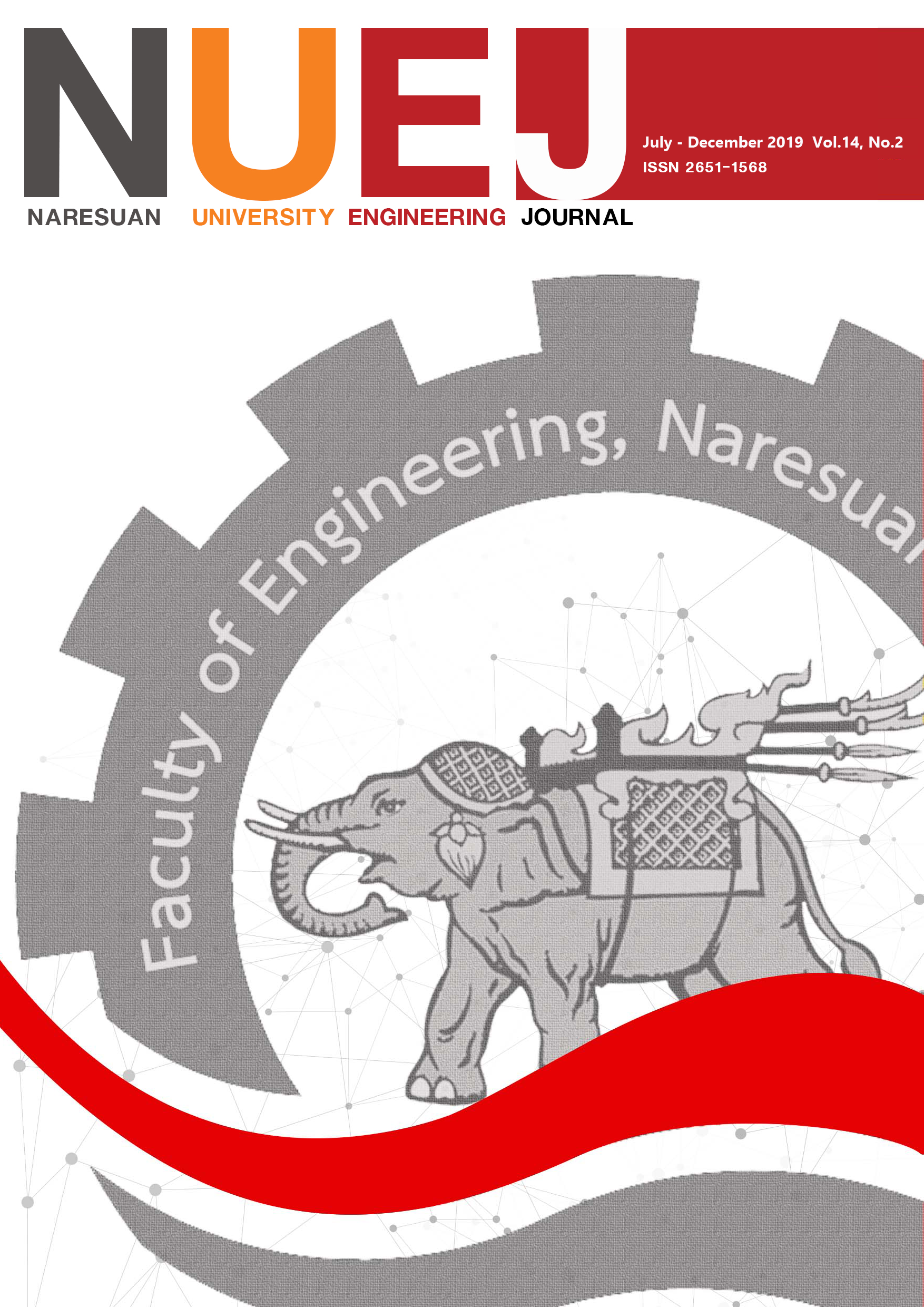Statistical Analysis of Water Quality Parameters in Downstream of Nan River, Thailand
Main Article Content
Abstract
The water quality analysis of the downstream of Nan river during 2012 to 2016 was carried out in this study. The secondary water quality data of 15 parameters in four station sites of NA07, NA05, NA03 and NA02 was provided by Pollution Control Department, Ministry of Natural Resource and Environment. The water quality index (WQI), which was calculated from 5 main parameters of dissolved oxygen, BOD, total coliform bacteria, fecal coliform bacteria and ammonia, was used to evaluate and monitor the water quality and together with statistical programmes (i.e., ANOVA, t-test, SPSS). The results presented that the average WQI was significantly decreasing by station sites; the value was around 70 at Station NA07 which is close to the midstream of Nan river, the value was 67 at Station NA05 which are the latter area, and the values were 62 and 61 at Stations NA03 and NA02 which are the furthest. Although the average WQI of all stations was categorized in moderate quality, the minimal WQIs of Stations NA05, NA03 and NA02 were categorized in poor quality. Nan river is potential area for water pollution. The significant parameters affecting the poor water quality were BOD, total coliform bacteria, fecal coliform bacteria. According to HCA analysis, the BOD was classified in the same component of turbidity, total solids and suspended solids which are easily measured. In the meanwhile, both bacteria were classified in the same component of pH. Therefore, the latter parameters can be used as primary parameters for pollution prevention in downstream of Nan river.
Article Details
References
Abd-Elwahed, M.S. (2018). Influence of long-term wastewater irrigation on soil quality and its spatial distribution. Annals of Agriculture Science, 63, 191-199.
Adimalla, N., & Qian, H. (2019). Groundwater quality evaluation using water quality index (WQI) for drinking purposes and human health risk (HHR) assessment in an agricultural region of Nanganur, south India. Ecotoxicology and Environmental Safety, 176, 153-161.
Auppaman, S. (2019). Illegal dumping of industrial waste at Nong Nae sub-district, Phanom Sarakham district, Chachoengsao.Waste and Hazardous Substance Management Bureau. www.pcd.go.th
Carstens, D., & Amer, R. (2019). Spatio-temporal analysis of urban changes and surface water quality. Journal of Hydrology, 569, 720-734.
Chen, W., & Liu, W. (2017). Investigating the fate and transport of fecal coliform contamination in a tidal estuarine system using a three-dimensional model. Marine Pollution Bulletin, 116, 365-384.
Greenpeace. (2007). Groundwater crisis from intensive fertilizer use in Thailand. www.greenpeace.org/archive-thailand
Gu, Q., Hu, H., Ma, L., Sheng, L., Yang, S., Zhang X., Zhang, M., Zheng, K., & Chen, L. (2019). Characterizing the spatial variation of the relationship between land use and surface water quality using self-organizing map approach. Ecological Indicators, 102, 633-643.
Inland Water Quality, Water Quality and Management, Pollution Control Department. (2018). Practical guide for surface water quality monitoring. www.pcd.go.th
Inland Water Quality, Water Quality and Management, Pollution Control Department. (2013). Water quality annual report 2012. http://infofile.pcd.go.th/mgt/WaterQuality.pdf
Kacar, A. (2011). Analysis of spatial and temporal variation in the level of microbial fecal indicators in the major rivers flowing into the Aegean Sea, Turkey. Ecological Indicators, 11, 1360-1365.
Liang, W., & Yang, M. (2019). Urbanization, economic growth and environmental pollution: Evidence from China. Sustainable Computing: Informatics and System, 21, 1-9.
Liu, C., Lin, K., & Kuo, Y. (2003). Application of factor analysis in the assessment of groundwater quality in a Blackfoot Disease area in Taiwan. Science of the Total Environment, 313, 77-89.
Mainali, J., & Chang, H. (2018). Landscape and anthropogenic factors affecting spatial patterns of water quality trends in a large river basin, South Korea. Journal of Hydrology, 564, 26-40.
Pitakwinai, P., Khanitchaidecha, W., & Nakaruk, A. (2019). Spatial and seasonal variation in surface water quality of Nan river, Thailand. Naresuan University Engineering Journal, 14, 1-6.
Pollution Control Department. (2011). Calculation of water quality index with 5 parameters. Inland Water Quality Sub-Division, Water Quality Management Division. www.pcd.go.th
Pollution Control Department. (2016). Water Quality and Management annual report 2016. https://www.stkc.go.th/sites/default/files/ebook/1507797423.pdf
Pollution Control Department. (2019). Secondary data of downstream of Nan River during 2012-2016. https://www.pcd.go.th
Pollution Control Department. (2019). Surface water quality. www.pcd.go.th
Sener, S., Sener, E., & Davraz A. (2017) Evaluation of water quality using water quality index (WQI) method and GIS in Aksu River (SW-Turkey). Science of The Total Environment, 584-585, 131-144.
Soithong, P., Youngsai, P., & Wachirawongsakorn, P. (2013, December 19-20). Quality aspects of domestic wastewater and Nan river in Phitsanulok. The 7th Rambhai Barni Rejabhat University Research Conference, Buriram Rajabhat University, Thailand.
Sonklin, W., & Photong, C. (2005). Water quality of Nan river flowing through agricultural and urban areas of Phitsanulok Province. Naresuan University Journal, 13, 37-44.
Sun, W., Xia, C., Xu, M., Guo, J., & Sun, G. (2016). Application of modified water quality indices as indicators to assess the spatial and temporal trends of water quality in the Dongjiang River. Ecological Indicators, 66, 306-312.
Wang, J., Fu, Z., Qiao, H., & Liu, F. (2019). Assessment of eutrophication and water quality in the estuarine area of Lake Wuli, Lake Taihu, China. Science of The Total Envrionment, 650, 1392-1402.
Yang, X., Warren, R., He, Y., Ye, J., Li, Q., & Wang, G. (2018). Impacts of climate change on TN load and its control in a River Basin with complex pollution sources. Science of The Total Environment, 615, 115-1163.
Yaqub, M., & Lee, W. (2019). Zero-liquid discharge (ZLD) technology for resource recovery from wastewater: A review. Science of The Total Environment, 681, 551-563.

